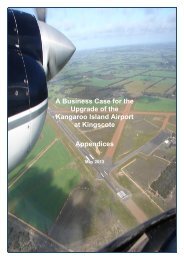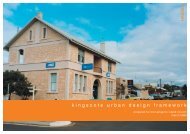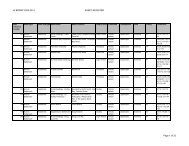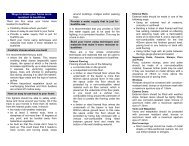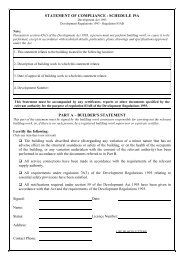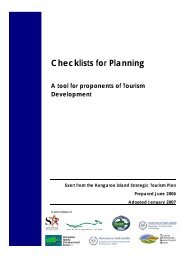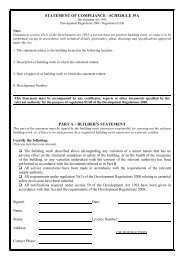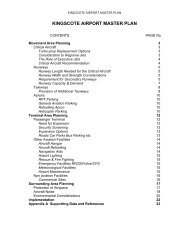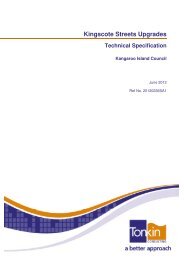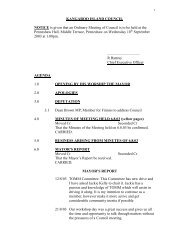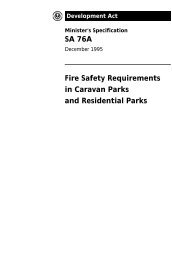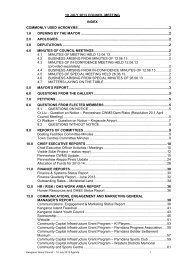KI Traveller's Levy Economic Impact Assessment - Kangaroo Island ...
KI Traveller's Levy Economic Impact Assessment - Kangaroo Island ...
KI Traveller's Levy Economic Impact Assessment - Kangaroo Island ...
Create successful ePaper yourself
Turn your PDF publications into a flip-book with our unique Google optimized e-Paper software.
Commercial-in-Confidence<br />
<strong>KI</strong> Traveller’s <strong>Levy</strong><br />
<strong>Impact</strong> <strong>Assessment</strong><br />
<strong>Impact</strong>s on residents<br />
The benefit of a levy for local residents (as residents – i.e. as distinct from resident business<br />
owners) will be an improvement in the quality of local infrastructure, particularly roads (at the<br />
very least, compared with a counterfactual where road conditions continue to deteriorate).<br />
Council will be better equipped to provide services to the local community and this will allow<br />
the amenity of local residents to be enhanced. The cost on residents depends primarily on<br />
whether they are required to pay the levy each time they commute to the <strong>Island</strong>.<br />
<strong>Impact</strong>s on Council<br />
For <strong>KI</strong> Council, a Traveller’s <strong>Levy</strong> would enable it to better undertake its role of servicing the<br />
community. Council services would not need to be cut in order to balance its budget and the<br />
pressure to find alternative revenue sources would be relieved.<br />
<strong>Impact</strong>s on the state economy<br />
As a region within the South Australian economy, in the first instance, any reduction in<br />
economic activity on <strong>KI</strong> (i.e. any fall in gross regional product) will be reflected in a<br />
commensurate reduction in economic activity for the state (i.e. a reduction in gross state<br />
product). However, there are also broader implications and flow-ons to consider.<br />
A proportion of those visitors who would have visited <strong>KI</strong> but are deterred by a levy may opt<br />
instead for alternative destinations in South Australia, thereby reducing the net impact on the<br />
state’s tourism industry. Conversely, where <strong>KI</strong> is a visitor’s primary motivation for travelling<br />
to South Australia, should a Traveller’s <strong>Levy</strong> deter visitation to the <strong>Island</strong>, it may be that the<br />
state loses not simply the <strong>KI</strong> expenditure, but additional expenditure throughout the state.<br />
The fact that those for whom visiting <strong>KI</strong> is the primary motivation for visiting SA will be among<br />
the most insensitive to price, suggests that this latter impact will not be large.<br />
Other flow-ons<br />
While it cannot be reliably captured in modelling, a further consideration is that a Traveller’s<br />
<strong>Levy</strong> may not merely impact on demand; it may also affect supply. If tourism operators – be<br />
that SeaLink, Air South or REX, or one of the myriad of tourism businesses on-island – were<br />
to experience or perceive sufficiently large adverse impacts as a result of a levy, their<br />
commercial response may be to withdraw supply. This is particularly true in the case of<br />
aviation, where the current market environment is tenuous and where capital is extremely<br />
mobile (i.e. an aircraft can be readily shifted from one route to another). That said, the<br />
segment of <strong>KI</strong> travellers who commute by air are perceived as among the most inelastic,<br />
hence the likelihood of service withdrawal as a direct result of a levy would appear low.<br />
Net impact on <strong>KI</strong><br />
The modelling outlined above demonstrates that, when purely price impacts are taken into<br />
account, a Traveller’s <strong>Levy</strong> of around ten dollars in value generates approximately the same<br />
value of revenue as is foregone in tourism income (depending on the specifics). Given<br />
sufficiently low cost of administration (see discussion in Section 5.2) this would suggest that,<br />
on net, a Traveller’s <strong>Levy</strong> has the potential to have a positive impact on <strong>KI</strong>. When a likely<br />
counterfactual whereby tourism visitation declines in the face of ailing infrastructure is<br />
considered, and the potential impact of an improvement in the quality of the <strong>KI</strong> experience is<br />
analysed, the net benefits are in fact likely to be greater.<br />
34



